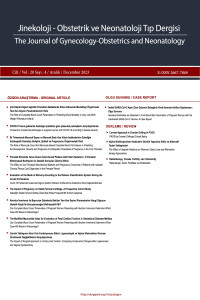Abstract
Amaç: Kartilaj tahribatının, aşırı kilo, eklemlerin aşırı kullanımı ve zorlanan hareketler, yaşlanma sürecine bağlı aşınmalar, genetik faktörler gibi birçok faktörle ilişkilendirildiği görülmüştür. Obezite, osteoartrit için değiştirilebilir bir risk faktörüdür. Bu çalışmada diz eklemi kartilaj kalınlığının belirlenmesi ve gebelik sürecinin gebelikte osteoartrit gelişimine etkisinin gösterilmesi amaçlandı.
Gereç ve Yöntem: Bu çalışmaya 15-42 yaş arası 50 hamile kadın dahil edildi. Baskın diz distal femoral kartilajın ultrason görüntüsü, kemik korteksi ile suprapatellar yağ yastığı arasındaki güçlü yankısız alandan lateral kondil, interkondiler alan ve medial kondilde 1. ve 3. trimesterde ölçüldü.
Bulgular: Nullipar ve multipar gebelerin her birinin üçüncü trimester kartilaj ölçümlerinin, birinci trimester kartilaj ölçümlerine göre anlamlı derecede daha ince olduğunu bulduk (p=0,001, p=0,005, p<0,001). Yaş, sosyoekonomik düzey, eğitim düzeyi, çalışma durumu, vücut kitle indeksi ve diz kartilaj ultrason ölçümleri arasında anlamlı ilişki bulundu (p=0,001 p=0,003, p=0,002, p=0,001).
Sonuç: Bu sonuçlara göre sosyoekonomik düzey, eğitim düzeyi, çalışma durumu ve vücut kitle indeksi kartilaj kalınlığını etkileyen faktörler olmasıyla birlikte, gebeliğin üçüncü trimesterine geçişinde ve multipar kadınlarda eklem kartilaj ölçümünde anlamlı azalma, gebelik sürecinin osteoartrit gelişiminde önemli bir faktör olduğunu düşündürmektedir.
Keywords
References
- 1. Dillon CF, Rasch EK, Gu Q et al. Prevalence of knee osteoarthritis in the United States: arthritis data from the Third National Health and Nutrition Examination Survey 1991-94. J Rheumatol 2006; 33: 2271-2279 2. VillafaNe JH, Pedersini P, Berjano P. Epigenetics in Osteoarthritis Related Pain: An Update. Arch Rheumatol 2020; 35: 456-457.
Abstract
Aim: Cartilage destruction has been associated with many factors such as overweight, excessive use of joints and forced movements, abrasion due to the aging process, and genetic factors. Obesity is a modifiable risk factor for osteoarthritis. This study aimed to determine the thickness of knee joint cartilage and demonstrate the impact of the pregnancy process on osteoarthritis development during pregnancy.
Matherial and Method: Fifty pregnant women aged 15-42 years, were included in this study. The ultrasound image of dominant knee distal femoral cartilage was measured at the 1st and 3rd trimesters in the lateral condyle, intercondylar area, and medial condyle from the strong anechoic area between the bone cortex and the suprapatellar fat pad.
Results: We found that the third trimester cartilage measurements for each of the nulliparous and multiparous pregnant women were significantly thinner than the first trimester cartilage measurements (p=0.001, p=0.005, p<0.001). A significant relationship was found between age, socioeconomic level, education level, employment status, body mass index, and knee cartilage ultrasound measurements (p=0.001 p=0.003, p=0.002, p= 0.001).
Conclusion: According to these results, although socioeconomic level, education level, employment status, and body mass index are factors affecting cartilage thickness, a significant decrease in joint cartilage measurement in multiparous women and the transition to the third trimester of pregnancy suggests that pregnancy is an important factor in the development of osteoarthritis.
Keywords
References
- 1. Dillon CF, Rasch EK, Gu Q et al. Prevalence of knee osteoarthritis in the United States: arthritis data from the Third National Health and Nutrition Examination Survey 1991-94. J Rheumatol 2006; 33: 2271-2279 2. VillafaNe JH, Pedersini P, Berjano P. Epigenetics in Osteoarthritis Related Pain: An Update. Arch Rheumatol 2020; 35: 456-457.
Details
| Primary Language | English |
|---|---|
| Subjects | Obstetrics and Gynaecology |
| Journal Section | Research Articles |
| Authors | |
| Publication Date | December 31, 2023 |
| Submission Date | November 19, 2023 |
| Acceptance Date | November 25, 2023 |
| Published in Issue | Year 2023 Volume: 20 Issue: 4 |


